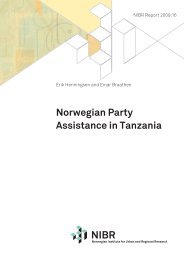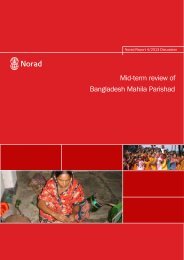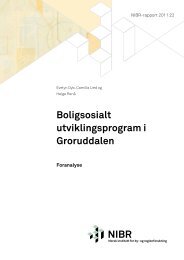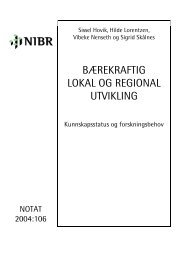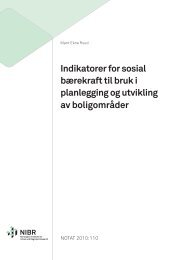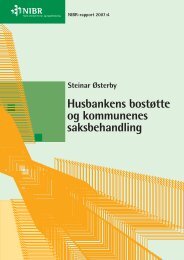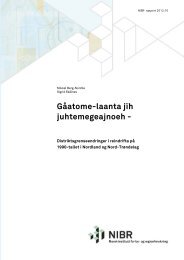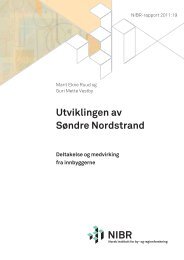http://www.tandfonline.com/page/terms-andconditions
The special importance of housing policy for ethnic minorities ...
The special importance of housing policy for ethnic minorities ...
- No tags were found...
You also want an ePaper? Increase the reach of your titles
YUMPU automatically turns print PDFs into web optimized ePapers that Google loves.
This article was downloaded by: [Norsk Institutt for By og]On: 11 March 2013, At: 07:07Publisher: RoutledgeInforma Ltd Registered in England and Wales Registered Number: 1072954 Registeredoffice: Mortimer House, 37-41 Mortimer Street, London W1T 3JH, UKInternational Journal of Housing PolicyPublication details, including instructions for authors andsubscription information:<strong>http</strong>://<strong>www</strong>.<strong>tandfonline</strong>.<strong>com</strong>/loi/reuj20The special importance of housingpolicy for ethnic minorities: evidencefrom a <strong>com</strong>parison of four NordiccountriesHans Skifter Andersen a , Lena Magnusson Turner b c & SusanneSøholt da Danish Building Research Institute, Aalborg University, Denmarkb Institute for Housing Research, Uppsala University, Swedenc NOVA Institute, Norwayd Norwegian Institute for Urban and Regional Research, NorwayVersion of record first published: 08 Mar 2013.To cite this article: Hans Skifter Andersen , Lena Magnusson Turner & Susanne Søholt (2013): Thespecial importance of housing policy for ethnic minorities: evidence from a <strong>com</strong>parison of fourNordic countries, International Journal of Housing Policy, DOI:10.1080/14616718.2013.764659To link to this article: <strong>http</strong>://dx.doi.org/10.1080/14616718.2013.764659PLEASE SCROLL DOWN FOR ARTICLEFull <strong>terms</strong> and conditions of use: <strong>http</strong>://<strong>www</strong>.<strong>tandfonline</strong>.<strong>com</strong>/<strong>page</strong>/<strong>terms</strong>-<strong>andconditions</strong>This article may be used for research, teaching, and private study purposes. Anysubstantial or systematic reproduction, redistribution, reselling, loan, sub-licensing,systematic supply, or distribution in any form to anyone is expressly forbidden.The publisher does not give any warranty express or implied or make any representationthat the contents will be <strong>com</strong>plete or accurate or up to date. The accuracy of anyinstructions, formulae, and drug doses should be independently verified with primarysources. The publisher shall not be liable for any loss, actions, claims, proceedings,demand, or costs or damages whatsoever or howsoever caused arising directly orindirectly in connection with or arising out of the use of this material.
International Journal of Housing Policy, 2013<strong>http</strong>://dx.doi.org/10.1080/14616718.2013.764659The special importance of housing policy for ethnic minorities:evidence from a <strong>com</strong>parison of four Nordic countriesHans Skifter Andersen a,* , Lena Magnusson Turner b,c and Susanne Søholt da Danish Building Research Institute, Aalborg University, Denmark; b Institute for HousingResearch, Uppsala University, Sweden; c NOVA Institute, Norway; d Norwegian Institute for Urbanand Regional Research, NorwayDownloaded by [Norsk Institutt for By og] at 07:07 11 March 2013The purpose of this article is to explore whether housing policy has a special importancefor immigrants, <strong>com</strong>pared with the whole population, by <strong>com</strong>paring housing policiesand immigrants’ housing out<strong>com</strong>es in four Nordic countries: Denmark, Finland, Norwayand Sweden. There are substantial differences between housing policies and housingout<strong>com</strong>es in Nordic countries, despite their <strong>com</strong>mon background as social-democraticwelfare states. The study shows that immigrants occupy a very different position onthe housing market in each of these countries, and in particular that the degree of overcrowdingamong immigrants <strong>com</strong>pared with the whole population varies a great deal.These differences can only to some extent be explained by inequalities between in<strong>com</strong>egroups on the housing markets in the countries: inequalities that affect immigrants.Other important explanations as to why immigrants have worse housing out<strong>com</strong>es isthe shortage of rental housing (e.g. in Norway), which increases the scope for discriminationand forces immigrants into overcrowded owner-occupied housing, and also rentand price control that create surplus demand and stronger <strong>com</strong>petition between househunters, which makes room for discrimination and reduces immigrants’ access to privaterenting in particular (e.g. in Denmark). Housing policy initiatives that improve immigrants’housing options are strict needs tests for social/public housing (as is the case inFinland).Keywords: immigrants’ housing situation; housing policies; Nordic countriesIntroduction and research questionIn the European literature there is a general consensus that immigrants and minority ethnicgroups face disadvantage in the housing market (Fonseca, McGarrigle, & Esteves, 2010).The literature on segregation and the housing market position of ethnic minorities in WesternEuropean cities has shown that minorities have typically been confined to the least desirableprivate or social/public rented housing in the inner city or in peripheral estates (Hamnett& Butler, 2008), as well as that immigrants fare very differently in the housing markets indifferent countries.This is also the case in four Nordic countries: Denmark, Finland, Norway and Sweden.These welfare states all belong to what is called the Scandinavian social democratic welfaremodel (Esping-Andersen, 1990), distinguished from other welfare state models by theirtendency to greater levels of equality. However these countries have quite different housingpolicies and housing markets (Bengtsson, Annaniassen, Jensen, Ruonnavaara, & Sveinsson,2006). All four of these Nordic countries have experienced substantial immigration over∗ Corresponding author. hsa@sbi.aau.dkC○ 2013 Taylor & Francis
2 H. Skifter Andersen et al.Downloaded by [Norsk Institutt for By og] at 07:07 11 March 2013the last 25 years, which has changed the <strong>com</strong>position of the population. All the countrieshave developed policies for integration of new residents alongside and interwoven withtheir universal welfare policies. Despite universal welfare policies, the majority of theimmigrants in all four countries find themselves in different housing positions from theethnic majority population. But immigrants’ housing position differs a great deal betweenthe countries, both in absolute <strong>terms</strong> and <strong>com</strong>pared with that of the native population.The purpose of this article is to examine the reasons why immigrants’ housing positiondiffers so much between four countries that are in many ways quite alike, and what can belearned from this about the effects of housing policy on immigrants’ housing options.Differences between different countries concerning immigrants’ housing conditionscan partly be a result of general differences in housing supply. We want to adjust for thesedifferences by <strong>com</strong>paring immigrants’ housing situation with that of the whole populationin the four Nordic countries, as described in the methodological section below. Our objectis to identify separate elements of housing policy that are of major importance in explainingwhy immigrants’ housing options differ from that of the native population.The article is structured as follows. It begins with a general discussion and literaturereview on determinants of housing preferences, options and choices of immigrants. Thenthere is a methodological and research design section. The <strong>com</strong>parison of the four Nordiccountries starts with a description of immigration to the countries, followed by a <strong>com</strong>parisonof housing policies and housing markets. Next, housing affordability in the countries isevaluated and the housing inequality between in<strong>com</strong>e groups is clarified. The housingoptions for immigrants are examined by making an assessment of immigrants’ access todifferent tenures and by an analysis of differences in the housing situation among theimmigrant population <strong>com</strong>pared with those of the whole population, measured by tenureprofile and overcrowding. In the last section, we analyse to what extent divergence inhousing policies can explain the different positions of immigrants on the housing markets.We draw conclusions regarding the particular importance of different elements of housingpolicy for the housing situation of the immigrant population.Literature on the determinants of immigrants’ housing choices and optionsIn European countries, housing preferences and housing choices of ethnic minorities canto a great extent be expected to have the same reasons as those of other citizens. Thatis, they depend on family situation, economic resources and local housing market possibilities.Unlike the native population, immigrants’ housing preferences also depend onexpectations concerning staying in the country or returning to where they came from, andtransnational relations. Regardless of reasons, evidence shows that the housing situationof ethnic minorities in most countries diverges much from that of the native population(see, for example, Musterd, 2005; Johnston, Forrest, & Poulsen, 2002; Finney, 2002; Blom& Henriksen, 2008; Fong & Chan, 2010). These differences cannot be fully explained bylower in<strong>com</strong>es among immigrants.Some studies explain the housing situation of ethnic minorities primarily via theirlack of resources. As well as economic resources, cognitive, political and social resourcesare important (Van Kempen, 2003). It is particularly these non-economic resources thatnewly arrived ethnic minorities often lack. In parts of the housing market, good contactsto persons or institutions are decisive for access to dwellings. This especially concernsprivate landlords. It is important to have relevant knowledge of the possibilities and ruleson the housing market, which also often requires good language skills or good access toadvisers. Exacerbating the disadvantage of low in<strong>com</strong>es, immigrants can thus also have
International Journal of Housing Policy 3Downloaded by [Norsk Institutt for By og] at 07:07 11 March 2013particular difficulties in accessing decent housing, which could be increased or lessenedby different elements of housing policy. For example, rules for access or loans to housingcan improve or hamper immigrants’ possibilities of getting access to certain tenures. If thehousing market is difficult to understand, it is likely to be more difficult for immigrantswith a limited knowledge of the host society to act on the market and find good solutionsto their housing needs (Søholt, 2007; Søholt & Astrup, 2009a).As has been established in studies of tenure preferences (Skifter Andersen, 2011; Artle& Varaiya, 1978), demand for homeownership is highly dependent on future expectations. Ifhouseholds expect stable future conditions like employment, rising in<strong>com</strong>e and permanentsettlement, they will be much more inclined to opt for homeownership. Newly arrivedimmigrants, especially, are often uncertain about their future and whether they will settlepermanently in the new country or go back to where they came from. It must therefore beexpected that immigrants, all things being equal, will have a higher preference for rentingthan the native population.Some studies (Aalbers, 2002; Andersson, 1998; Skifter Andersen, 2008; Søholt &Astrup 2009a; Molina, 2010) point to discriminatory practices in the housing market thatdisadvantage ethnic minorities. In particular, social/public and private landlords to a certainextent exclude ethnic minorities from their housing. The extent to which discriminationoccurs can depend on the way housing tenures are regulated and supported through housingpolicy. If access to housing is very dependent on decisions made by administrators ofhousing and is subject to local discretion, there is greater scope for discrimination than ifthere are strict rules on the allocation of vacant dwellings. Moreover, the level of demandfor the housing in question is important: if demand greatly exceeds supply there will bequeues, which will tend to generate conditions more conducive to discrimination. Onemanifestation of discrimination in the private rental market is that immigrants may haveto pay more than the native population, if there is no rent regulation (Røed Larsen &Sommervoll, 2011). Surplus demand can either be a result of price and rent regulationsthat keep prices and rents below market levels, or could be due to a housing shortage ingeneral, or that the supply of publicly supported housing for low-in<strong>com</strong>e groups is toolow. There could also be discriminatory practices among banks or institutions providingcapital for the purchase of housing if, as a result of prejudice, ethnic minorities are seen asless solvent customers. Discrimination against immigrants by financial institutions can beinfluenced by the extent of public subsidies for housing and can be reduced by public loanguarantees.In many countries in northern Europe, immigration has grown in recent years and therehas been a general tendency among immigrant families to settle in certain parts of thehousing market, in limited parts of the cities (Musterd, Ostendorf, & Breebaart, 1998). Inmany countries they have settled in social/public housing. In this way some neighbourhoodsin the cities have gained a large proportion of ethnic minorities and have been transformedinto what we call ‘multi-ethnic neighbourhoods’, in which the majority ethnic population hasbe<strong>com</strong>e a minority. It has been shown (Musterd, 2005; Johnston et al., 2002; Finney, 2002;Fong & Chan, 2010) that there is great variation between different ethnic groups concerningthe extent that they live in neighbourhoods with a high concentration of immigrants.Preferences for living in neighbourhoods with fellow countrymen could be importantin influencing which tenures and dwellings immigrants try to obtain and the kind ofac<strong>com</strong>modation they can access. In different countries, ethnic enclaves and multi-ethnicneighbourhoods have been established in tenures, depending on how easy it has beenfor immigrants to gain access to these tenures. In some countries it has taken place inprivate rented housing, in others in social/public housing and sometimes in owner-occupied
4 H. Skifter Andersen et al.Downloaded by [Norsk Institutt for By og] at 07:07 11 March 2013housing. A hypothesis could be formulated that neighbourhoods with less attractive housingdominated by an easy to access tenure provide the basis for an initial influx of immigrants(Scaffer & Huang, 1975; Bleiklie, 1997; Søholt, 2007; Søholt & Astrup, 2009a).When the presence of ethnic groups be<strong>com</strong>es very visible, segregation processes called‘white flight’ and ‘white avoidance’ begin to appear. In the US it has been observed thatwhites ‘flee’ when the number of black residents in their neighbourhood exceeds a certainproportion of the population (Wright, Ellis, & Parks, 2005). A British study (Simpson &Finney, 2009) has shown that white flight is less important in the British case. In recentyears there has been a tendency to replace the concept of white flight with the more general‘white avoidance’, meaning that natives tend to avoid moving to neighbourhoods with manyimmigrants or special ethnic groups (Clark, 1992; Quillian, 2002; Bråmå, 2006; Bråmå &Andersson, 2010). As a consequence of these processes, it is easier for immigrants to gainaccess to these neighbourhoods, which are often dominated by certain tenures.As a result of the factors discussed above, and the segregation processes that follow,immigrants tend to reside in certain tenures and in less attractive or low-quality housing,often concentrated in certain neighbourhoods. The results are influenced by the structureof the housing market and the national and local housing policies that shape it.Methodology and research designAs stated in the introduction, we aim to <strong>com</strong>pare housing policies in four Nordic countriesin order to identify elements that have a special importance for the housing options andchoices of immigrants. This will be done by analysing the extent to which immigrants’housing position deviates from that of the whole population in the relevant country.One of the main reasons why immigrants’ housing situations diverge from those ofthe native population is that in general they have lower in<strong>com</strong>es. It is therefore of greatimportance for immigrants as to what extent there is sufficient affordable housing, withsatisfactory access possibilities to the different housing segments for low-in<strong>com</strong>e groups.If low-in<strong>com</strong>e households in general have good access to affordable and decent housing,immigrants will benefit greatly from this. We therefore have to examine to what extentthe housing position of immigrants on the housing markets can be explained by in<strong>com</strong>einequalities. If immigrants’ housing position can be fully explained by in<strong>com</strong>e inequalitiesand in<strong>com</strong>e differences between immigrants and the native population, there are no specialeffects of housing policies on immigrants.Housing inequalities between in<strong>com</strong>e groups, meaning to what extent housing opportunitiesfor different in<strong>com</strong>e groups are equal or unequal, will be measured by differencesin overcrowding between in<strong>com</strong>e groups in order to clarify whether there are high or lowdifferences in housing consumption between in<strong>com</strong>e groups, and by <strong>com</strong>paring ‘in<strong>com</strong>esegmentation’ in the housing market; that is, how different in<strong>com</strong>e groups are distributedon housing tenures. Segmentation of the housing market is a concept that has been usedto describe the way different people are allocated to different parts of the housing market(Lindberg & Lindèn,1989) or that different parts of the housing market are designed tomeet different kinds of demand (Rothenburg, Galster, Butler, & Pitkin, 1991).In<strong>com</strong>e segmentation is created when different tenures are, to a major extent, madeavailable and attractive for households in different in<strong>com</strong>e groups. Segmentation oftenmeans that high-in<strong>com</strong>e groups are concentrated in certain parts of the housing market,mainly owner-occupied detached housing, while low-in<strong>com</strong>e groups mostly reside in poorquality rental housing or social/public housing. Segmentation can result from the wayhousing subsidies are designed. Tax subsidies in owner-occupation are most favourable
International Journal of Housing Policy 5Downloaded by [Norsk Institutt for By og] at 07:07 11 March 2013for high-in<strong>com</strong>e groups, while only low-in<strong>com</strong>e groups can get housing allowances inrental housing. Segmentation can also result from the way access to tenures is regulated.Sometimes only low-in<strong>com</strong>e groups can access subsidised social/public housing.In this article, the housing out<strong>com</strong>es of immigrants are characterised by two measures.The first is the immigrants’ achieved position in housing tenures <strong>com</strong>pared with that of thewhole population. This is called the ‘ethnic segmentation of the housing market’.The housing market segmentation of immigrants gives a picture of to what extentimmigrants have easy or difficult access to different housing tenures, especially to homeownershipand social/public housing. Particularly in American literature on the processesof integration (assimilation) of immigrants (Borjas, 2002; Alba & Nee, 1997), homeownershipis often seen as a sign of positive social integration. In this light a high segmentationof immigrants, resulting in a higher representation in rental housing, could be seen as a signof weak integration and failed integration policies. Another negative aspect related to highsegmentation is that different tenures tend to be concentrated in different neighbourhoods.High segmentation can therefore result in higher segregation of immigrants and concentrationin low-cost tenures, often social/public housing in particular neighbourhoods (SkifterAndersen, Andersen, & Ærø., 2000).The second measure used in this article to <strong>com</strong>pare immigrants’ housing positionbetween the four Nordic countries is the proportion of immigrants living in overcrowdeddwellings <strong>com</strong>pared with the whole population. This ‘relative overcrowding’ is a measureof to what extent the housing consumption, which immigrants have obtained, differs fromthe general level of the countries.In the final analysis, our focus is on how the differences in ethnic segmentation andrelative overcrowding between the countries can be explained by differences in housingpolicies, housing markets and housing stocks. We distinguish between conditions thatincrease or decrease the housing options of low-in<strong>com</strong>e groups, and conditions that havea special significance for immigrants beside the effects for low-in<strong>com</strong>e groups. We tryto find explanations for differences in overcrowding and why immigrants are over- orunderrepresented in different tenures in the countries by looking at specific elements oftheir housing policies. We also examine whether the differences between immigrants’housing position in the various countries can be explained by differences in the position ofin<strong>com</strong>e groups.The data used in the article <strong>com</strong>e from many different statistical sources and it hasnot been easy to obtain <strong>com</strong>parable data. The sources of the data are specified withinrelevant tables. Some of the data have been collected in connection with the NODESproject (Andersson et al., 2010); other data have been collected separately from nationalstatistical offices. Data on homeownership rates in in<strong>com</strong>e groups stems from an EU survey.Immigration to the four Nordic countriesIt has been demonstrated in several studies that different ethnic groups can have varyinghousing preferences and perform differently on the housing market (Skifter Andersen 2012).There are differences especially between immigrants <strong>com</strong>ing from Western countries andthose <strong>com</strong>ing from non-Western countries. When in the following sections we look atexplanations for differences between the four Nordic countries, it is therefore important tobe aware of the differences in the immigration to the countries.As described in Andersson et al. (2010), there are some important distinctions in thenature of the immigration to the four Nordic countries. The extent of immigration varies,
6 H. Skifter Andersen et al.Table 1. Immigrants living in four Nordic countries and the proportion of them <strong>com</strong>ing from EasternEurope and Non-European countries.Denmark Finland Norway SwedenProportion of population born outside the 9.8 4.4 10.8 14.3country,%Immigrants from Eastern Europe,% 0.8 1.7 1.8 3.2Immigrants from non-Europeancountries,%4.5 1.5 5.0 6.2Source: Anderson et al. 2010.Downloaded by [Norsk Institutt for By og] at 07:07 11 March 2013as shown in Table 1. Finland has received much fewer immigrants than the other countries,while the share of immigrants in Sweden is about 40% higher than in Denmark and Norway.Moreover, the ethnic <strong>com</strong>position of immigrants varies between the countries. Mostimmigrants to Finland <strong>com</strong>e from Eastern Europe, especially Russia. Finland has relativelyfew immigrants from countries outside Europe, <strong>com</strong>pared with the other three countries,in which a total of 5% of the whole population are immigrants who originate from outsideEurope. Norway, Finland and Sweden also have many immigrants from Eastern Europe.Housing policies in the four Nordic countriesThe function of the housing markets is out<strong>com</strong>e result of policies influencing housingconditions. The important issue in this article is whether housing policy has a differentimpact on the housing of the immigrant population than that of the majority population.In the following sections we will present major traits of housing policies and housingmarkets in the four Nordic countries to explain immigrants’ position and segmentation inthe housing market. There is not the space for a detailed description in this article, but amore thorough description can be found in Skifter Andersen (2012).Housing policy can be defined as public initiatives that affect the supply, price andquality of dwellings, as well as how they are distributed among households. Housing policyis to some extent intertwined with urban policy, which influences where and how dwellingsare located and the qualities of neighbourhoods.Some general features of housing policies can be indicated that are important forimmigrants. As stated above, immigrants’ housing options are very dependent on the generaloptions on the housing market for low-in<strong>com</strong>e groups, and the ethnic segmentation of themarket depends much on the degree of in<strong>com</strong>e segmentation. This segmentation dependson the extent that housing policy creates equal opportunities and economic incentives indifferent tenures. If housing subsidies or tax incentives are designed in such a way thathigh-in<strong>com</strong>e groups receive the largest support in owner-occupation and only low-in<strong>com</strong>egroups are supported in rental housing, it can be expected that there will be pronouncedin<strong>com</strong>e segmentation. Yet, if housing policy is more universalistic, in the sense that it isto a greater extent aimed at housing for the whole population and not only for vulnerablelow-in<strong>com</strong>e groups, in<strong>com</strong>e segmentation will be lower.Another important feature is whether housing policy makes the market more, or less,transparent. Complicated systems of economic support and rules for access to housingmake it more difficult for immigrants, with limited knowledge of the housing systems, toidentify good housing options. Connected to this is whether conditions for discriminationare enhanced. If rules for access to rental dwellings are unclear, or if allocation is entrustedto landlords alone, the risk of discrimination is greater.
International Journal of Housing Policy 7Downloaded by [Norsk Institutt for By og] at 07:07 11 March 2013Housing policies vary much between Nordic countries in spite of their <strong>com</strong>mon backgroundas social democratic welfare states. In a <strong>com</strong>parison of housing policy instrumentsin the four countries (Lujanen, 2004), it was said that ‘surprisingly big differences’ werefound in implementation and in the means used. Similarly, another <strong>com</strong>parative study ofhousing policy in the four Nordic countries (Bengtsson et al., 2006, p. 12) concludes that theway housing policy has been implemented in the different countries shows such importantdifferences that one can talk about quite different housing systems: differences in policies,institutions and markets. Danish and Swedish housing policies are characterised by beingmore general and universalistic. In Norway and Finland there are, to a greater extent, specialpolicies for low-in<strong>com</strong>e groups regulated by means tests.Sweden has been the country that has put most weight on housing as a social goodwith equal housing possibilities for all (Turner & Whitehead 2002; Magnusson Turner,2010). Denmark also had strong social objectives for housing but not as pronounced asin Sweden. More weight has been placed on the market and less on state control. Earlier,Norway had a strong state control of housing finance with supply subsidies for all kinds oftenures, but this has been abolished since the 1990s. Policies in Norway have always beenmore selective and needs tests have been extensive. In Finland, housing policy, to a greaterextent than in the other three countries, has been seen as social policy for the weaker groupsin society. Housing policy has earlier been characterised as ‘provisional’ (Niva, 1989) oras ‘non-policy’ (Juntto, 1992). What is meant is that housing policy to a greater extenthas been a kind of ad-hoc policy adjusted to economic fluctuations and actual problemsappearing on the housing market.One of the reasons for the differences in the <strong>com</strong>position of the housing markets,shown in Table 2, is that political objectives concerning the desirability of different kinds ofhousing tenures have differed. Sweden is the only country that has had an explicit objectiveto give equal status to all tenures. In Norway, it has been an explicit political notion thathomeownership is the most desirable kind of housing for all. Rental housing is regarded asa temporary stage in the housing career. Denmark and Finland have not formulated politicalobjectives concerning tenures, but in practice their policies have been most favourable forowner-occupation.One of the key elements in housing policy, the provision of a social/public housingsector, has been carried out somewhat differently in the countries (see Table 2).Twenty yearsago Sweden had the largest social/public housing sector, but conversion into cooperativeshas reduced the sector to 14% of the housing stock. Finland has about the same amountof social/public housing, while Denmark has the largest sector (21%). In Norway, thesocial/public housing sector is very small, only about 5% of the stock.Table 2.Tenure <strong>com</strong>position of the housing markets.Denmark Finland Norway SwedenDistribution of dwellings on tenure,%Owner-occupied 53 59 62 52Cooperatives 7 1 14 18Private renting 19 14 19 15Social/public housing 21 16 5 14Other 10Total 100 100 100 100Source: Anderson et. al. 2010.
8 H. Skifter Andersen et al.Downloaded by [Norsk Institutt for By og] at 07:07 11 March 2013Instead of social/public housing, Norway has historically focused on cooperative housingas housing for middle- and low-in<strong>com</strong>e groups. Today, prices for cooperative housing inthe metropolitan region have increased to the same level as homeownership. The main supportis to supply low-in<strong>com</strong>e households with subsidised state loans and housing allowancesin order to be able to buy and keep a dwelling, regardless of the nature of ownership. Thecooperative sector is of very little importance in Finland and forms only a small sector inDenmark. Sweden has the largest cooperative sector. It can to some extent be seen as asubstitution for owner-occupied flats, which to a limited extent exist in Sweden, and theaverage in<strong>com</strong>es in the sector are above average (see Table 5). The history of cooperativesin Norway and Sweden is somewhat similar and in both countries the sector is dominated bylarge housing associations. Cooperatives in Denmark are quite different. They have mostlybeen converted from private renting and been subject to a strict price control, which has tosome extent been lifted in recent years.Overall, the rental sector is largest in Denmark with about 40% followed by Swedenwith 30%, Finland with 30% and Norway with 23%.In all of these countries private renting has been declining over time in both absoluteand relative size. In Denmark and Norway, it is still about one-fifth of the stock, while inSweden it now accounts for 15% of dwellings and in Finland 14%. There are, however,marked differences between the countries, concerning the conditions for private renting.Denmark still has a strict rent control; Sweden has a modest control; while rents in Norwayand Finland are determined by the market. In Denmark and Sweden, rent regulation to someextent results in rents below market rents. This is especially the case in Denmark, whererents are very differentiated with at the same time very low rents in part of the market andvery high rents in others.The size of the owner-occupied sector differs somewhat as a more or less direct effectof housing policies. Norway and Finland have the largest sectors (62 and 59% respectively).In Denmark and Sweden, owner-occupied housing accounts for somewhat more than halfof the stock. However, if cooperatives are viewed as a kind of owner-occupation, Norwayhas the largest share with 76% followed by Sweden with 70%.The <strong>com</strong>position of tenures in some neighbourhoods with low quality or low-cost housing,which immigrants have had an easy access to, has to some extent initiated the processof segregation of immigrants. In turn, this has influenced immigrants’ choice of tenuresand their housing situation. The first immigrants to Denmark, Norway and Sweden tendedto settle in older neighbourhoods in cities, dominated by private renting. This has especiallybeen the case in Norway. Over the course of time, immigrant-dense neighbourhoodsin Denmark, Finland and Sweden emerged in areas dominated by social/public housing.In Norway, immigrant-dense neighbourhoods developed in areas dominated by cooperatives.As described in the theoretical section, there is evidence from countries such asSweden and the United States (Bramå, 2006; Wright et al., 2005) that immigrant-denseneighbourhoods tend to attract more immigrants due to white flight and avoidance, andto some extent due to preferences for ethnic enclaves. It is therefore to be expected thatsegregation has increased the presence of immigrants in social/public housing in Denmark,Finland and Sweden, while in Norway it has been important for immigrants’ settlement incooperatives.Evaluation of housing affordability in the countriesImmigrants most often belong to low- and moderate-in<strong>com</strong>e groups. Of decisive importancefor immigrants’ housing options is their ability to pay housing costs and to get loans for
International Journal of Housing Policy 9Downloaded by [Norsk Institutt for By og] at 07:07 11 March 2013acquisition of owner-occupied dwellings and cooperative housing. This, on the one hand,depends on price and rent levels on the housing market, on the other hand on housingsubsidies and finance systems. It is not an easy task to disentangle the effects of housingpolicy because prices and rents on the housing markets are affected by subsidies andfinance. Subsidies are thus to some extent passed on to the prices on the market. Moreover,the structure of subsidies not only influences access and the possibility of keeping adwelling, but also the kind of tenures that are produced. For example, high indirect taxsubsidies promote homeownership. Social/public housing requires the existence of specificsubsidies.Table 3 shows an evaluation of the differences in affordability for household with lowerin<strong>com</strong>es in the different tenures in the countries. The table is based on a detailed <strong>com</strong>parisonand evaluation of housing prices, rents and subsidy systems in four Nordic countries (SkifterAndersen, 2012). Below is a further argument for the judgements.Social/public housing in Denmark is in principle affordable for everyone. Also, in Finland,rent setting and subsidies make social/public housing affordable. The municipalities’autonomy in rent-setting principles for social/public housing in Norway has resulted inmarket prices in the metropolitan area (Medby & Langsether, 2007). To survive this rentpolicy, tenants are dependent on housing allowance, often <strong>com</strong>bined with social allowance.Rents, which are below market rents in the private renting sector in Denmark andSweden (only in the more urbanised areas), may make these dwellings more affordable.This is especially the case in Denmark, but rents are differentiated with very low rentsin part of the market and at the same time very high rents in others. Earlier lower priceson cooperatives in Denmark made them more affordable, but in recent years prices haveincreased to market levels in parts of the stock.Affordability in owner-occupied housing depends on property prices, finance systems,tax support and supply support. Subsidies and state guaranties for loansmake it easier for first time buyers and low-in<strong>com</strong>e groups to acquire a home inNorway, Finland and Sweden. Low-in<strong>com</strong>e homeowners in Norway also benefit fromhousing allowance. However, new research documents that twice as many of the immigrantpopulation have debts three times their yearly in<strong>com</strong>e, <strong>com</strong>pared with the whole population(Ellingsen, 2011). Combined with the fact that immigrants in Norway have a large shareof ownership, the high rate of borrowing can be interpreted as indicating that the lack ofrental housing and difficult conditions for immigrants on the rental market, have resultedin some immigrants with lower in<strong>com</strong>es being pushed to enter the owner occupied marketin order to get a satisfactory home.Table 3. Comparison between four Nordic countries regarding the affordability of low-in<strong>com</strong>egroups in different tenures.Denmark Finland Norway SwedenTenureSocial housing +++ +++ ++ +++Private renting ++ ++ + ++Cooperatives, etc. +++ ++ ++Owner-occupied + + + ++Most affordable: +++Least affordable: +
10 H. Skifter Andersen et al.Table 4.Homeownership among households in different in<strong>com</strong>e quartiles.Homeownership,% ∗ )Denmark Finland Norway SwedenHousehold in<strong>com</strong>e quartile1 50 53 42 512 52 65 54 603 66 71 74 624 82 74 88 71All 62 67 62 59Index for in<strong>com</strong>e segmentation 29 18 33 14Downloaded by [Norsk Institutt for By og] at 07:07 11 March 2013Source: First European Quality of Life Survey: Social dimensions of housing <strong>http</strong>://<strong>www</strong>.eurofound.europa.eu/pubdocs/2005/94/en/1/ef0594en.pdf and Norway: Levekårsundersøkelsen 2007.Index of segmentation = sum(abs(proportion of homeowners in quartile–proportion of homeowners for the wholepopulation))/100.In<strong>com</strong>e inequalities on the four Nordic housing marketsImmigrants tend to have lower in<strong>com</strong>es than the rest of the population. The housingsituation of immigrants can thus partly be explained by differences in the housing situationof different in<strong>com</strong>e groups in the various countries. In the following we will look at thesedifferences described by the extent of tenure segmentation and differences in overcrowdingbetween in<strong>com</strong>e groups.In<strong>com</strong>e segmentation of the housing marketIt has been difficult to obtain <strong>com</strong>parable data on in<strong>com</strong>e segmentation in the variouscountries. In Table 4 the proportion of homeowners in different in<strong>com</strong>e quartiles isTable 5.Average personal in<strong>com</strong>e among residents 16+ years in different tenures.Denmark Finland Norway SwedenAverage disposable in<strong>com</strong>es in tenures (eEuro)Owner-occupied 27,149 20,021 30,408 21,100Cooperatives 21,556 – 28,328 19,900Private renting 21,130 14,623 20,246 16,300Social/public housing 19,415 14,028 21,763 14,850All 24,407 18,233 27,645 19,200Relative difference from average in<strong>com</strong>e, per cent%Owner-occupied 11 10 10 10Co-operatives −12 2 4Private renting −13 −20 −27 −15Social/public housing −20 −23 −21 −23Index for in<strong>com</strong>e segmentation 14 12 13 11Index of segmentation = sum(abs(in<strong>com</strong>e in tenure- average in<strong>com</strong>e) ∗ proportion of dwellings in tenure))/100.Sources:Denmark: Database at Danish Building Research Institute based on data from Statistics Denmark 2008.Finland: Statistics Finland 2008.Norway: Levekårsundersøkelsen 2007.Sweden: GeoSweden 2011.
International Journal of Housing Policy 11Downloaded by [Norsk Institutt for By og] at 07:07 11 March 2013<strong>com</strong>pared, while Table 5 <strong>com</strong>pares the average personal in<strong>com</strong>es in the different tenures.Based on these statistics, two indices of in<strong>com</strong>e segmentation have been calculated asshown at the bottom of each table. Table 4 shows to what extent households in differentin<strong>com</strong>e groups are separated between owning and renting. Table 5 shows to what extentmeasures of personal in<strong>com</strong>e diverge between different tenures.Table 4 shows that a much lower proportion of the households in the lowest householdin<strong>com</strong>e quartile in Norway are homeowners <strong>com</strong>pared with the other countries. In thehighest in<strong>com</strong>e quartile the proportion is higher. The calculated index of segmentation inTable 4 is much higher in Norway than in the other three countries. Table 5 also shows thatthe personal in<strong>com</strong>es in rented housing are relatively lower in Norway than in the othercountries. However, the calculated index of segmentation in Table 5 covering all tenures isnot very different from that of the other countries.The housing market in Denmark is not quite as in<strong>com</strong>e segmented as the Norwegianone, but more segmented than in Sweden and Finland. The figures from Sweden indicatethat the Swedish political goal of equal opportunities in different tenures has to some extentbeen achieved (Table 4).The unequal distribution of overcrowdingAnother way to look at unequal opportunities is to <strong>com</strong>pare overcrowding of differentin<strong>com</strong>e groups. In Table 6 the proportion of households in different in<strong>com</strong>e quartilesliving in overcrowded dwellings is <strong>com</strong>pared between four Nordic countries. An indexfor in<strong>com</strong>e inequality between in<strong>com</strong>e groups is calculated as the sum of the absolutedifferences between overcrowding in each group and the whole population includingimmigrants.The table indicates, surprisingly, that Sweden has the highest differences betweenin<strong>com</strong>e groups and Norway the lowest. Only 14% of the households in the lowest quartilein Norway live in overcrowded housing, while Table 10 shows that 45% of immigrants(individuals) in Norway are in this situation. Given market pricing of all housing in Norway<strong>com</strong>bined with immigrants’ low in<strong>com</strong>es, one explanation could be that many immigrantsare forced into smaller owner-occupied dwellings. Moreover, most of the rentals are smalldwellings (Schmidt, 2009).Table 6. Proportion of households in different in<strong>com</strong>e quartiles living in overcrowded dwellings2006 (%).Denmark Finland Norway SwedenHousehold in<strong>com</strong>e quartile1 18 20 14 262 7 10 7 123 6 6 5 94 3 4 3 5All 8 10 7 13Index for in<strong>com</strong>e inequality 19 20 14 26Source: Nordisk Socialstatistisk Komité, cited in Normann, Rønning, & Nørgaard (2009).Index = Sum q = 1–4 (abs(overcrowd q – overcrowd all )).
12 H. Skifter Andersen et al.Downloaded by [Norsk Institutt for By og] at 07:07 11 March 2013Evaluation of immigrants’ access to housing in different tenuresImmigrants’ access to social/public housing is determined by the general rules for allocationof vacant dwellings and the extent to which local authorities have the right of disposal ofdwellings to allocate to low-in<strong>com</strong>e groups. In all countries, local authorities have anobligation to provide housing for new refugees, which most often results in settlement insocial/public housing.In Denmark and Sweden, access to social/public housing is in principle based on anopen allocation system with waiting lists. In recent years, however, access to social/publichousing in Denmark has be<strong>com</strong>e somewhat more difficult for immigrants due to the newrules of allocation that have been introduced in estates with many immigrants. In Finland,as in Norway, access is based on urgent housing needs, which favours the most vulnerableimmigrants but not the more successful.In Denmark, rent control in the private rented sector produces queues that do notfavour immigrants and tend to reduce their possibilities of accessing the sector, becauseimmigrants seldom know landlords personally and some landlords do not want to lettheir properties to immigrants (Skifter Andersen, 2008). In Norway, the small rental sectorincreases the <strong>com</strong>petition between house hunters who want to rent, which provides afertile environment for discrimination. Moreover, the market is dominated by small landlordsletting one or a few dwellings, who tend to avoid immigrants as tenants (Nordvik,1996; Søholt & Astrup, 2009a). However, private professional renting <strong>com</strong>panies seemto be increasing in Oslo. These landlords let a range of types of rentals which seem tobe more accessible for immigrants. Finland has a more professionalised private rentalsector, which puts weight on allocation by market mechanisms and should facilitate immigrants’access if they can pay the rent, and discrimination does not take place. InSweden it is permissible for municipalities to establish a central housing allocation service,which is open to immigrants, but the landlords are not obliged to use it, so herepersonal contacts with landlords are also important. Table 9 indicates that immigrantsin Sweden and Finland have much easier access to private renting than in Norway andDenmark.Cooperatives in Denmark differ very much from cooperatives in Sweden andNorway. Access to Danish cooperatives has been very difficult for immigrants, becauseallocation of dwellings has been controlled by the boards of the cooperatives, which insteadof immigrants have often chosen family or friends. In recent years prices have risen insome places to the market level, which in principle should make it easier for immigrants toget access if they can pay these prices. In Norway access to cooperatives is market based,<strong>com</strong>bined with seniority as members of the association. The applicants have to be formallyaccepted by the boards of the cooperatives, but there is not much room for discrimination. InSweden allocation is market based. In new construction, which earlier was given subsidies,waiting lists are used, with seniority as the allocation principle.Access to owner-occupied housing is market based in all the countries. There is notmuch research on discrimination against home buyers in the Nordic countries. Avoidingstrategies from sellers, neighbours and estate agents are however documented in Norwaybut seem to be less frequent than discrimination in the rental market (Søholt, 2007; Søholt& Astrup, 2009a). But immigrants could have difficulties in gaining loans or mortgagesfor housing. This depends very much on the kinds of finance and subsidies available in thevarious countries, which is discussed below.In Table 7 an evaluation is made of the ease with which immigrants access differenttenures in the countries. It takes into account the issues identified above concerning supply
International Journal of Housing Policy 13Table 7. Evaluation of the ease of access for immigrants to different housing tenures in the Nordiccountries ∗ .Denmark Finland Norway SwedenTenureSocial housing +++ ++ + ++Private renting – ++ + ++Cooperatives, etc. – +++ +++Owner-occupied +++ +++ +++ +++Easy access: +++Greater obstacles: –∗ The evaluation of the ease of access is based on a <strong>com</strong>bination of available housing and factors which especiallyhamper the options of immigrants.Downloaded by [Norsk Institutt for By og] at 07:07 11 March 2013of different tenures and of the described rules for access and practices of administration.Three factors are considered in determining these evaluations: the relative size of the tenure,which especially applies to the rental sectors; specific rules regulating access; and, finally,whether conditions on the market make room for discrimination of immigrants.Our conclusion is that Denmark has the most differentiated housing market with greatdifferences between immigrants’ opportunities for access to the tenures.Access to social/public housing is most difficult in Norway. In all the countries studied,private renting is the least accessible tenure. Access to cooperatives is most difficult inDenmark due to price regulations. Access to ownership is based on market conditions inall the countries.Comparison of immigrants’ housing situation in four Nordic countriesAs described in the introduction, we will <strong>com</strong>pare immigrants’ housing situation in thefour countries by looking at the ethnic segmentation of the housing markets, that is howimmigrants are distributed across housing tenures, and to what extent immigrants live inovercrowded dwellings.Ethnic segmentationEthnic segmentation on the housing market can be examined by <strong>com</strong>paring the distributionof immigrants on tenures with the distribution of the whole population. Tables 8 and 9show how immigrants are distributed across tenures and their over or under-representationin each form of tenure. Moreover, an index of segmentation for each country is shown.The index is calculated as the sum of the absolute value of the difference between theproportion of immigrants in each tenure and the proportion of the whole population livingin that tenure, weighed by the proportion of the whole population living in the tenure.The tables show significant differences between the four countries regarding immigrants’distribution on tenures. In particular Norway differs by having a substantially largerproportion of immigrants living in owner-occupied housing. In the other three countries,homeownership is at about the same level, accounting for about 30 per cent of dwellings.In all countries, immigrants are under-represented in the owner-occupied tenure, but ashomeownership is not at the same level in the various countries, immigrants are less oftenhomeowners in Finland than in Denmark and Sweden. This could partly be due to the fact
14 H. Skifter Andersen et al.Table 8. Immigrants and the whole populations distributed on tenures in four Nordic countries (%).Denmark Finland Norway SwedenDownloaded by [Norsk Institutt for By og] at 07:07 11 March 2013ImmigrantsOwner-occupied 30 31 45 30Cooperatives 6 18 23Private renting 16 21 24 26Social/public housing 45 43 13 20Other 2 5Total 100 100 100 100Total populationOwner-occupied 62 72 62 55Cooperatives 6 14 17Private renting 14 11 19 14Social/public housing 17 13 5 14Other 1 4Total 100 100 100 100Year and sources:Denmark: 2008, Database at the Danish Building Research Institute based on data from Statistics Denmark.Finland: 2010, Statistics Finland.Norway: Living conditions among immigrants in Norway 2005/2006 and living conditions among the wholepopulation 2007, survey data Statistics Norway.Sweden: GeoSweden 2008.that immigrants in Finland have arrived later than in the other countries and have had lesstime to ‘climb up the housing ladder’.There are also remarkable differences between the countries concerning immigrants’representation in the other tenures. In Denmark and Finland a large proportion of immigrantslive in social/public housing, while it is only 20% in Sweden and 13% in Norway. The lowproportion in Norway is due to the very small social/public housing sector. When it <strong>com</strong>esto immigrants’ over-representation in social/public housing, Norway is at the same levelas Denmark, while Finland has the largest over-representation. Immigrants are also overrepresentedin social/public housing in Sweden, but at a lower level than in the othercountries.Private renting is an important sector for immigrants in all the countries studied, ac<strong>com</strong>modatingbetween 15 and 25%. But <strong>com</strong>pared with the size of this tenure, immigrants havemore often gained access to private renting in Finland and Sweden. Especially in Denmark,Table 9.Immigrants’ overrepresentation in the tenure and a calculated index of tenure segmentation.Denmark Finland Norway SwedenOwner-occupied −51 −57 −27 −45Cooperatives −4 29 37Private renting 18 91 26 89Social/public housing 166 222 160 45Other 113 40Index of segmentation 63 81 34 50Over representation = (% of immigrants in tenure x –% of whole population in tenure x)/% of whole populationin tenure x.Index of ethnic tenure segmentation = sum x=1,n (Absolute (% of immigrants in tenure x –whole population intenure x) ∗ proportion of population in tenure x).
International Journal of Housing Policy 15Downloaded by [Norsk Institutt for By og] at 07:07 11 March 2013immigrants do not very often live in private renting. A Danish study (Skifter Andersen,2010) has shown that after taking into account that immigrants’ in<strong>com</strong>es are lower thanthe average, immigrants have a 60% lower probability of living in private rented dwellings.Immigrants thus less often live in private renting in Denmark than what would be expectedconsidering their lower in<strong>com</strong>es.In Norway and Sweden, cooperatives are important for immigrants, who are overrepresentedin the sector in both countries, especially Sweden. One reason could be that thereis little room for discrimination in the access process. Again the Danish case differs greatlyfrom the others, because immigrants less often live in cooperatives than the population as awhole. Considering their in<strong>com</strong>es, the probability of immigrants moving into cooperativesis much smaller again because low-in<strong>com</strong>e groups in Denmark more often move intocooperatives (Skifter Andersen, 2010).The calculated index of segmentation shown at the bottom of Table 9 indicates substantialdifferences between immigrants’ position on the housing market in the four countries.Finland is the country where the largest deviation is found between immigrants’ housingtenure and the rest of the population. Denmark has the second largest deviation followedby Sweden. In Norway, immigrants’ housing tenure is most like the national average.OvercrowdingOur second measure to <strong>com</strong>pare immigrants housing position between four Nordic countriesis relative overcrowding. Table 10 shows figures for overcrowding measured as theproportion of residents living in dwellings with less than one room per person. The relativedifference between immigrants and the whole population is calculated as the percentage bywhich overcrowding for immigrants exceeds overcrowding for the whole population.The figures are not quite <strong>com</strong>parable. In Norway, the number of households is reducedwith single adults in one-room dwellings, but this has only a small effect on the <strong>com</strong>parisonbetween the countries.Table 10 shows that overcrowding among immigrants is much more <strong>com</strong>mon in Norwaythan in the other countries. Compared with the whole population, immigrants live five tosix times more often in overcrowded housing. Immigrants’ housing in Finland is alsoquite often overcrowded but this can partly be explained by a generally high degree ofovercrowding in the country. Immigrants’ level of overcrowding is close to the same levelTable 10. Proportion of immigrants and whole population living in densely populated housing ∗ inthe Nordic countries (%).Denmark Finland Norway SwedenWhole population 7 18 8 16Immigrants 28 41 45 26Relative difference % 289 128 463 61∗ More than one person per room (kitchen and bath excluded).Denmark:. Foreign-born persorns and their children 2008 16+ years. Database at the Danish Building ResearchInstitute based on data from Statistics Denmark.Finland: Data on households 31.12.2008, immigrants = households headed by a foreign-speaking person, Source:Statistics Finland.Norway: Source: Foreign-born persons and their children. Age 16—70 years. Statistics Norway. Level of livingamong immigrants 2005/2006. Survey to a representative selection among 10 groups. Level of living in the wholepopulation 2007. Single adults in one-room dwellings excluded.Sweden: Foreign–born persons 16+ years. Statistic Sweden, Survey on living conditions 2007.
16 H. Skifter Andersen et al.in Denmark and Sweden. However, because the population in Denmark in general livesmore seldom in overcrowded dwellings, the difference between immigrants and the wholepopulation is much greater than in Sweden. It can therefore be concluded that immigrants’housing situation, with respect to overcrowding, differs most from that of the population asa whole in Norway followed, in decreasing order, by Denmark, Finland and Sweden.Downloaded by [Norsk Institutt for By og] at 07:07 11 March 2013ConclusionsWe have shown that the housing situation of immigrants in the four Nordic countriesdiffers a great deal. It is also documented that differences in immigrants’ position in thehousing market cannot be explained by differences between the countries with respect toimmigration and general in<strong>com</strong>e inequalities alone. This indicates that elements of housingpolicies may have special effects for the housing situation of immigrants.The evidence presented in this article identifies important differences between thefour countries regarding immigrants’ distribution on tenures in the housing markets. Theanalysis shows that immigrants in Finland are most unequally distributed between tenures,measured by our index of tenure segmentation, while immigrants in Norway are the leastsegmented. Denmark and Sweden are positioned somewhere in between, with the strongestsegmentation in Denmark.Norway differs in particular by having a larger proportion of immigrants living inowner-occupied housing than in the other countries. Compared with the whole population,immigrants are less often homeowners in Finland than in Denmark and Sweden.In Denmark and Finland, a large proportion of immigrants lives in social/publichousing, while the share is very low in Norway due to its small social/publichousing sector. Compared with the whole population, Finland has the largest overrepresentationof immigrants in social/public housing, followed by Norway andDenmark which are at the same level. The lowest level of over-representation is foundin Sweden. Private renting is an important sector for immigrants in all the countries. Butimmigrants have the easiest access to private renting in Finland and Sweden. Especiallyin Denmark, immigrants do not very often live in private renting and less often livein this tenure than what would be anticipated given their lower in<strong>com</strong>es. Cooperativesare an important sector for immigrants in Sweden and Norway. This is not the case inDenmark where immigrants live less often than the average in cooperatives, and areunder-represented; especially when one considers their lower in<strong>com</strong>es.This paper shows large differences in immigrants’ housing situation measured by degreeof overcrowding. The drawback of the Norwegian housing system is that immigrants moreoften live in overcrowded dwellings than in the other countries. In Norway and Finland avery high proportion of immigrants live in overcrowded dwellings <strong>com</strong>pared with Denmarkand Sweden. But overcrowding in general differs between the countries and the picture issomewhat different if one looks at how immigrants’ housing situation differs from that ofthe whole population. The gap between immigrants and the whole population is largest inNorway. It is also quite large in Denmark and lowest in respectively Finland andSweden.If tenures are strongly divided into housing for the rich and poor, immigrants to alarge extent will be concentrated in housing for the poor. We examined whether the variationsin housing out<strong>com</strong>es for immigrants among the four countries can be explained bydifferences in in<strong>com</strong>e inequalities and in<strong>com</strong>e segmentation in the housing systems. Thehousing out<strong>com</strong>es for different in<strong>com</strong>e groups vary a great deal between the countries withrespect to segmentation and overcrowding. But, when one <strong>com</strong>pares the countries, there
International Journal of Housing Policy 17Downloaded by [Norsk Institutt for By og] at 07:07 11 March 2013is no systematic connection between in<strong>com</strong>e inequality and ethnic inequality in housingout<strong>com</strong>es.The Norwegian housing market has higher in<strong>com</strong>e segmentation than the other countries.Thus, in the case of Norway the low tenure segmentation of immigrants cannot beexplained by low-in<strong>com</strong>e segmentation. When <strong>com</strong>paring Denmark with Sweden and Finland,the higher tenure segmentation of immigrants can be associated with higher in<strong>com</strong>esegmentation. Differences in in<strong>com</strong>e segmentation can thus to some extent explain whyimmigrants are more unequally distributed among tenures in Denmark than in Sweden. Butit cannot explain why the ethnic segmentation is higher on the Finnish market and loweron the Norwegian. In the Finnish case, one explanation could be that immigrants are to agreater extent new<strong>com</strong>ers and that larger proportions of Danish, Swedish and Norwegianimmigrants have had longer time to ‘climb up the housing ladder’.It is also difficult to explain the differences between the various countries concerningimmigrants in overcrowded housing as caused only by variation across the countriesconcerning differences between in<strong>com</strong>e groups. The high degree of overcrowding amongimmigrants in Norway can thus not be explained by differences between in<strong>com</strong>e groups,which are in fact smaller than in the other countries. The differences between the othercountries cannot be accounted for by in<strong>com</strong>e differences. Some of the differences musttherefore be explained by particular features in the housing systems.The central research question examined in this article is whether a <strong>com</strong>parison ofimmigrants’ housing situation and of housing policies in four Nordic countries makes itpossible to identify specific elements of national housing policies that have had a specialsignificance for the housing out<strong>com</strong>es of immigrants.Our <strong>com</strong>parison of countries reveals that ethnic tenure segmentation, which often resultsin spatial segregation of immigrants, is only to some extent a consequence of in<strong>com</strong>esegmentation of housing markets. This indicates that differences in housing policies canhave special consequences for immigrants additional to the effect on in<strong>com</strong>e groups.The Norwegian case shows that a lack of sufficient rental housing in a country can pushimmigrants into owner-occupation, which could be seen as desirable. But the price for thispolicy has been that many immigrants live in overcrowded ac<strong>com</strong>modation. Moreover, thelack of rental housing results in a high demand pressure on rental housing. This makesroom for increased rents but also discrimination, which has been well documented in theNorwegian case (Røed Larsen & Sommervoll, 2011; Søholt & Astrup, 2009a).In the other three countries, there is more rental housing and social/public housing,especially in Denmark. But these sectors have been organised differently. Important differencesfor immigrants are rent and price controls in private renting and cooperatives, thesize of the social/public housing sector, and rules of access to social/public housing.The Danish case shows that immigrants’ housing options and experience of discriminationare strongly influenced by regulation of the private rental market and a lack oftransparency in housing transactions. Strong rent control, as in Denmark, is damaging thehousing possibilities of immigrants in private renting because rents below the market levelcreate queues, which give landlords options to choose between house hunters. They tend tochoose family and acquaintances as tenants, and, as immigrants seldom have good informalcontacts with landlords, they experience difficulties in gaining access to these dwellings.Moreover, the room for direct discrimination increases, which has to some extent beendocumented in Denmark. Also, price control in cooperatives in Denmark has resulted in astrong under-representation of immigrants in this tenure because of stronger <strong>com</strong>petitionbetween house hunters, which immigrants tend to lose in absence of personal contacts tomembers of the co-operatives.
18 H. Skifter Andersen et al.Downloaded by [Norsk Institutt for By og] at 07:07 11 March 2013A large social/public housing sector, such as that found in Denmark and, before 2000,in Sweden, paves the way for good housing opportunities for immigrants. Open accessto social/public housing for all in<strong>com</strong>e groups increases immigrants’ housing options.However, the lessons from Finland are that if housing policy is concentrated on support forhousing for the poor, who are housed in social/public housing allocated strictly on the basisof need, immigrants tend to be very concentrated in this kind of housing. Also, in Denmarkthere is a high concentration of immigrants in social/public housing. This can partly beexplained by a housing policy that in general has resulted in higher-in<strong>com</strong>e segmentationon the housing market than in Sweden and Finland. The universalistic housing policy inSweden of giving equal status to all tenures has resulted in a modest ethnic segmentationof the housing market and in a smaller over-representation of immigrants in social/publichousing. It has also resulted in smaller differences between immigrants and the nativepopulation concerning overcrowding.The high over-representation of immigrants in social/public housing in Denmark andFinland has led to spatial segregation and to a high concentration of immigrants appearingin certain neighbourhoods in the cities. It can be assumed that processes of ethnic spatialsegregation such as ‘preferences for enclaves’ and ‘white flight and avoidance’ have occurredin these neighbourhoods and thus have contributed to increased over-representationin social/public housing. Also, in Sweden large housing estates with high concentrationsof immigrants exist where these processes may have occurred. In Norway, concentrationsof immigrants have mostly occurred in neighbourhoods with cooperatives. But it doesnot seem that these immigrant-dense neighbourhoods in Norway and Sweden have to thesame extent contributed to a concentration of immigrants in respectively cooperatives andsocial/public housing.AcknowledgementsThis article was developed as a part of the NODES project (Nordic welfare states andthe dynamics and effects of ethnic residential segregation <strong>http</strong>://blogs.helsinki.fi/nodesproject/)financed by NORFACE. It is based on material from a report <strong>com</strong>paring four countries (Anderssonet al., 2010) and a special paper on housing policies (Skifter Andersen, 2012). It will be followedby another article illuminating the consequences for segregation in the four capitals.The description of Finnish housing policy is based on a section in Andersson et al. (2010) written bySaara Yousfi, Katja Vilkama, and Mari Vaattovaara, University of Helsinki. Katja Vilkama has alsocontributed with <strong>com</strong>ments to this article and some data. Furthermore Rolf Barlinghaug, NorwegianInstitute for Urban and Regional Research has contributed with some Norwegian data.ReferencesAalbers, M. B. (2002). The neglected evidence of housing market discrimination in the Netherlands.Radical Statistics Journal, 79/80, 161–169.Alba, R., & Nee, V. (1997). Rethinking assimilation theory for a new era of immigration. InternationalMigration Review, 31, 826–874.Andersson, R. (1998). Socio-spatial dynamics: Ethnic divisions of mobility and housing in post-PalmeSweden. Urban Studies, 35, 397–428.Andersson, R., Dhalmann, H., Holmquist, E., Kauppinen, T. M., Turner, L. M., Skifter Andersen,H., ... Yousfi, S. (2010). Immigration, housing and segregation in the Nordic welfare states.Helsinki: Department of Geosciences and Geography, University of Helsinki.Artle, R., & Varaiya, P. (1978). Life cycle consumption and homeownership. Journal of EconomicTheory, 18, 38–58.Bengtsson, B., Annaniassen, E., Jensen, L., Ruonnavaara, H., & Sveinsson, J. R. (2006). Varför såolika? Nordisk bostadspolitik i jämförande historisk ljus.Malmö: Egalitè.
International Journal of Housing Policy 19Downloaded by [Norsk Institutt for By og] at 07:07 11 March 2013Bleiklie, I. (1997). Service regimes in public welfare administration. Case studies of street-levelbureaucrats and professionals as decision makers. Oslo: Tano Aschehougs Fonteneserie.Blom, S., & Henriksen, K. (2008). Levekår blant innvandrere i Norge 2005/2006 [Living conditionsamong immigrants in Norway 2005/2006]. Report 5. Oslo: Statistics Norway.Borjas, G. J. (2002). Homeownership in the immigrant population. Journal of Urban Economics, 52,448–476.Bråmå, Å. (2006). ‘White flight’? The production and reproduction of immigrant concentration areasin Swedish cities, 1990–2000. Urban Studies, 43, 1127–1146.Bråmå, Å., & Andersson, R. (2010). Who leaves rental housing? Examining possible explanations forethnic housing segmentation in Uppsala, Sweden. Journal of Housing and the Built Environment,25, 331–352.City of Oslo. (2011). Endringer i forskrift om tildeling av kommunal bolig i Oslo kommune [Changesin the regulations for allocation of municipal dwellings in the municipality of Oslo]. Høringsbrev.Byrådsavdeling for eldre og sosiale tjenester.Clark, W. A. V. (1992). Residential preferences and residential choices in a multiethnic context.Demography, 29, 451–466.Damn, A. P. (2002). Etniske minoriteters bosætning og flytninger – de seneste 20 års økonomiskkvantitative forskningsresultater [The settlement and moves of Ethnic minorities; The quantitativeresults form the last 20 years of economic research]. AMID Working Paper Series 13/2002.Aalborg University.Ellingsen, D. (2011). Mange låner mye in Samfunsspeilet [Many citizens borrows much in the gameof society], No. 4. Oslo: Statistics Norway.Esping-Andersen, G. (1990). The three worlds of welfare capitalism. Cambridge: Polity.Finney, N. (2002). Ethnic group population change and interaction: A demographic perspective onethnic geographies. Ethnicity and integration. Understanding Population Trends and Processes, 3,27–45.Fong, E., & Chan, E. (2010). The effect of economic standing, individual preferences, and co-ethnicresources on immigrant residential clustering. International Migration Review, 44, 111–141.Fonseca, M. L., McGarrigle, J., & Esteves, A. (2010). Possibilities and limitations of <strong>com</strong>parativequantitative research on immigrant’s housing conditions. Working paper No. 06. PROMINSTAT.Institute of Geography and Spatial Planning, University of Lisbon, Portugal.Hamnett, C., & Butler, T. (2010). The changing ethnic structure of housing tenures in London,1991–2001. Urban Studies, 47(1), 55–74.Johnston, R., Forrest, J., & Poulsen, M. (2002). Are there ethnic enclaves in English cities? UrbanStudies, 39, 591–618.Juntto, A. (1992). Post-industrial housing crisis: Finland as a case study. In L. J. Lundqvist (Ed.), Policy,organization, tenure. A <strong>com</strong>parative history of housing in small welfare states. ScandinavianHousing and Planning Research, Supplement 2, 47–59.van Kempen, R. (2003). Segregation and housing conditions of immigrants in Western European cities.Eurex Lecture 7 – 13 March. Retrieved from <strong>http</strong>://<strong>www</strong>.shiva.uniurb.it/eurex/syllabus/lecture7/Lecture7-VanKempen.pdfLindberg, G., & Lindèn, A.-L. (1989). Social segmentation på det svenske bostadsmarknaden [Socialsegmentation on the Swedish housing market]. Lunds: Sociologiske Institutionen, LundsUniversitet.Lujanen M. (Ed.). (2004). Housing and housing policy in the Nordic countries. Nord2004:7. Copenhagen:Nordic Council of Ministers.Magnusson Turner, L. (2010). Study on housing and exclusion. Country report Sweden. EuropeanCommission.Medby, P., & Langsether, Å. (2007). Den kommunale utleiesektor [The municipal rented sector].NOVA Rapport 12/07. Oslo: NOVA and SINTEF Byggforsk.Molina, I. (2010). Nedslag i diskriminering på bostadsmarknaden [Signs of discrimination on thehousing market]. Unpublished report to the Equality Ombudsman (DO), Oslo.Musterd, S. (2005). Social and ethnic segregation in Europe: Levels, causes and effects. Journal ofUrban Affairs, 27, 331–348.Musterd, S., Ostendorf, W., & Breebaart, M. (1998). Multi-ethnic metropolis: Patterns and policies.Dordrecht: Kluwer.Niva, M. (1989). Bostad, politik och marknad [Housing, policy and market]. Stockholm: NordiskInstitut för Samhällsplanering.
20 H. Skifter Andersen et al.Downloaded by [Norsk Institutt for By og] at 07:07 11 March 2013Nordvik, V. (1996). Mot et mer ustabilt leiemarked [Towards a more stable rental market]. Samfunnsspeilet,4, 15–18.Normann, T. M., Rønning, E., & Nørgaard, E. (2009). Utfordringer for den nordiske velferdsstaten –sammenlignbare indikatorer [Challenges for the Nordic Welfarestate – <strong>com</strong>parable indicators].Copenhagen: Nordic Social-Statistical Committee (NOSOSKO).Quillian, L. (2002). Why is black–white residential segregation so persistent? Evidence on threetheories from migration data. Social Science Research, 31, 197–202.Rothenberg, J., Galster, G., Butler, R. V., & Pitkin, J. R. (1991). The maze of urban housing markets:Theory, evidence and policy. Chicago, IL: University Press of Chicago.Røed Larsen, E., & Sommervoll, D. E. (2011). Prisdannelsen i det norske leiemarkedet: En teoretiskog empirisk analyse av hovedmekanismer generelt og utsatte grupper spesielt [Price formationon the Norwegeian rental market: A theoretical and empirical analysis of main mechanisms andthe importance for marginalised groups]. In NOU 2011:15 Rom for alle. En sosial boligpolitikkfor framtiden. Oslo: Ministry of Local Government and Regional Development, 20 pp.Schaffer, B., & Huang, W. (1975). Distribution and the theory of access. Development and Change,6(2), 13–36.Schmidt, L. (2009). Små boliger – en kunnskapsoversikt. NIBR-report 1. Norwegian Institute forUrban and Regional Research, Oslo.Simpson, L., & Finney, N. (2009). Spatial patterns of internal migration: Evidence for ethnic groupsin Britain. Population, Space and Place, 15(1), 37–56.Skifter Andersen, H. (2008). Privat boligudlejning. Motiver, strategier og økonomi. Hørsholm: StatensByggeforskningsinstitut.Skifter Andersen, H. (2010). Spatial assimilation in Denmark. Why do immigrants move to and frommulti-ethnic neighbourhoods? Housing Studies, 25(3), 281–300.Skifter Andersen, H. (2011). Motives for tenure choice during the life cycle. Housing, Theory andSociety, 28(2), 183–207.Skifter Andersen, H. (2012). The importance of housing policies and housing markets for the housingof immigrants in the Nordic countries. Report for the NODES project. Horsholm: Danish BuildingResearch Institute at Aalborg University.Skifter Andersen, H., Andersen, H. T., & Ærø, T. (2000). Social polarisation in a segmented housingmarket. Segregation in greater Copenhagen. Geografisk Tidsskrift, 100, 71–83.Søholt, S. (2007). Gjennom nåløyet – en sammenligning av tilpasninger til boligmarkedet blanthushold av pakistansk, tamilsk og somalisk bakgrunn, Oslo 197 –2003]Through the eye of aneedle – a <strong>com</strong>parison of adaptions to the housing market among households with Pakistani,Tamil and Somali background, Oslo 1970–2003] (Unpublished master’s thesis). Oslo: Institutefor Political Science, Faculty of Social Sciences, University of Oslo.Søholt, S., & Astrup, K. (2009a). Etniske minoriteter og forskjellsbehandling i leiemarkedet [Ethnicminorities and unequal treatment in the rental market]. NIBR-report: 2. Oslo: Norwegian Institutefor Urban and Regional Research.Søholt, S., & Astrup, K. (2009b). Etterkommere av innvandrere – bolig og bostedsmønster [The secondgeneration of immigrants – housing and housing patterns]. NIBR-report: 3. Oslo: NorwegianInstitute for Urban and Regional Research.Turner, B., & Whitehead, C. (2002). Reducing housing subsidy: Swedish housing policy in aninternational context. Urban Studies, 39, 201–217.Wright, R., Ellis, M., & Parks, V. (2005). Re-placing whiteness in spatial assimilation research. Cityand Community, 5, 111–135.



